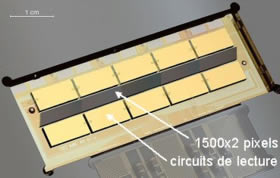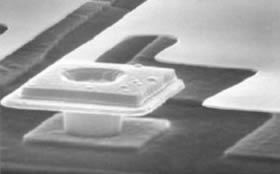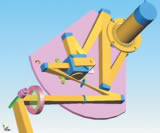Infrared light detectors allow all the objects that are not at the same temperature as their environment to be observed. They have many applications in the military and civilian fields. But these detectors are more complex than visible spectrum cameras, since they themselves emit infrared radiation. Several technologies coexist to cover all uses.
Number 28
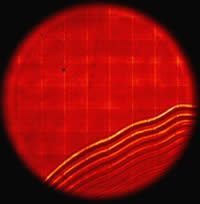 Image obtained by a multi-quantum-well infrared detector. The fringes observed translate into a spectrometry function. |
Unlike serpents, we have very poor sight at night. This is because we are only sensitive to the light called visible, with wavelengths between approximately 400 and 800 nanometres. To see at night, we would have to detect the radiation with a longer wavelength emitted by each person or each object at ambient temperature. This is the infrared spectrum, a light radiation whose wavelengths vary between around 1 and 30 micrometers. The detection of infrared radiation is of course of interest to the Defence for night time combat or for guiding missiles. However, it can also have civilian applications: industrial process monitoring, cartography of turbulence areas in meteorology, astrophysics, or even air and water pollution monitoring. Two methods can be used: thermography consists in making infrared emission maps, while remote sensing aims toward obtaining information from each pixel, for example regarding the nature of the object picked out. |
|
|
|
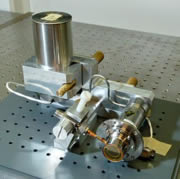 The "Mistere" instrument infrared detector. The detector (on the right) is integrated to its cryostat and linked to the cooling machine by the inverted U cooling line. |
In the infrared spectrum, everything is more complicated than in the visible spectrum. Indeed, every object at ambient temperature emits infrared radiation. It is thus usually necessary to cool the detector, or otherwise, it dazzles itself, due to the heat that it dissipates. Detector cooling methods vary, depending on the desired applications. One possibility is to circulate a cryogenic liquid (a substance that remains liquid at very low temperatures, for example nitrogen or helium). "This solution can be used in the lab, but it is not practical for on-board applications, where it is preferable to use cooling machines", points out Isabelle Ribet. |
|
|
|
| Finally, the detectors known as "multi-quantum-well detectors" appeared more recently, in the eighties. They are made of a stack of thin layers of gallium arsenide (GaAs) and gallium-aluminium arsenide (AlGaAs), with the characteristic of being able to detect wavelengths over 12 microns. This wavelength range is especially interesting for applications such as astronomy, where it is necessary to detect radiation from very distant objects, which emit very little light. Unfortunately, the potential of multi-quantum-well detectors for such applications is currently limited by their low quantum yield and by their very low operating temperatures. Timbre-Poste |
|
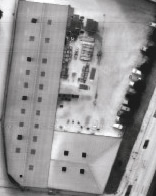 Détail d'une image radiométrique obtenue par Timbre Poste |
ONERA participates in several projects involving very high-performance infrared detectors. We can, for example, mention the high-quality radio-imaging "Timbre Poste" project. Either on board a helicopter or placed on the ground, this system is used to make maps of the amount of light emitted for each wavelength: known as the luminance. Areas of activity such as a port or an industrial area can also be picked out. Infrared imaging can then distinguish discharges of waste or even a docked oil tanker filling its tanks (since the petroleum must be heated to make it more liquid). "The level of detail is terrific: you can make out the electrical cables and pylon" says Isabelle Ribet enthusiastically. There are of course military applications (characterization of the theatre of operations, marking a target for a missile, etc.), but there are also civilian applications, for example, monitoring pollution. But first, the simulation codes must be validated, i.e. the detectors must be numerically helped to recognize each object, taking into account all of the interference, such as the atmosphere. To do this, a measurement campaign is carried out at well known sites and the results of the simulations are compared to the real data. |
|
Mistere Another important application: spectroradiometry. Rather than looking at all of the radiation emitted by objects, it is a case of determining the emission "spectrum" for each object, that is to say, to observe what their emission is for each wavelength. Each element has a different infrared signature. |
|
|
|
Materials can also be distinguished, for example metals can be distinguished from trees. “Mistere” (with an "i" because it is the French acronym for Infrared Terrain Spectrometric Means for the Evaluation of Reflectivity and Emissivity (Moyen Infrarouge Spectrométrique de Terrain pour l’Évaluation des Réflectivités et des Émissivités) is a terrain spectroradiometer associated with a program capable of reconstituting the emissions of objects from the information obtained. The compact instrument is arranged on a support with a rotating arm, which allows concentric measurements to be made for an object. “Mistere” can obtain spectral information over a very broad spectrum (from 2.9 to 9.6 µm). |
| "Infrared detection also requires significant modelling work, says the researcher. For a given scene, what would the detector receive? We are developing calculation codes to foresee this. We must also create databases on the emissions of many elements, in order to be able to compare the terrain measurements with known emissions." The treatment of infrared data could also yield more. Each range of wavelengths has its advantages and disadvantages. By combining several spectral ranges, it is possible to be effective in several situations (climate, meteorological conditions, day/night). Better still: by comparing the results for different range of wavelengths, the radiation from a truck exposed to the sun can be differentiated from that of a truck from which a missile is launched, since the emission from a flame is highly specific. When all of the infrared wavelengths are observed, these differences cannot be observed. Expertise and measurement The team in which Isabelle Ribet works is not in charge of manufacturing infrared detectors. "We carry out expertise missions, we evaluate the performance of the detectors, all technologies combined”, says the researcher. “Thus, the Aiquido laboratory (Analysis, interpretation, qualification and integration of optical detectors), directed by Marcel Caes, is a reference laboratory for other bodies, such as the Armaments Procurement Agency (Délégation Générale à l’Armement, DGA)". Each type of detector has advantages and disadvantages and a detector can only be judged based on the applications for which it is intended. This is why there are several different technologies. "We also carry out an orientation activity: |
|
"BRASIL" (French acronym for Specific Angular Response Bank for the Distant Infrared) test bank. |
we look for the most promising of the emerging technologies and study the fundamental physics involved in these detectors. In addition, we develop original measurement techniques, in order to measure the ultimate performance of the detectors. Thus, we know how to measure currents of less than one femtoampere (10-15 amperes, in other words, a millionth of a thousandth of an ampere)." In short, Isabelle Ribet’s group develops test banks for infrared detectors. "We sometimes show that certain measurements are essential for characterizing the performance of a detector. This is the case of angular response: light sometimes reaches the detector perpendicularly and sometimes it reaches it at a slant. Also, the detector must provide the same result whatever the angle of incidence of the ray. We have developed a test bank to characterize this angular response, and this, specifically for distant infrared radiation". Soon, we may get along even better that the serpent is able to at night. |
|
Cécile Michaut, scientific reporter. |
|



